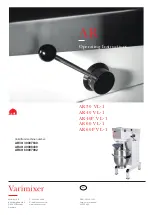
12–1
12 - Front panel
This section explains the different parts of the front
panel of the TM-D4000.
Within this section there are also detailed explana-
tions of some system conguration, etc. procedures,
which are linked to particular controls. In particular,
explanations are given for the conguration k eys,
which are located to the left of the display screen.
12.1System controls, etc.
These keys and indicators provide access to functions
that control the whole of the TM-D4000 system.
They include controls for automation, fader-to-chan-
nel layers, library functions, conguration and gen-
eral mixer controls.
[1]
Clock and Fs indicators
This section consists of indicators giving the current
word clock status of the TM-D4000.
These
Fs
indicators show the sampling frequency
currently being used by the TM-D4000, either
48k
or
44.1k
.
If the sampling frequency from the selected clock
source is out of range, or is not available, the appro-
priate
CLOCK
indicator will ash.
The sampling frequency may either be internally
generated, or derived from an external source. See
3.2, “CLOCK setup” for details.
These
CLOCK
indicators show the source of the
word clock currently being used by the TM-D4000:
either
INT
(internal),
SLOT
(taken from one of the
interface cards tted in the e xpansion slots,
D-IN
(from one of the stereo digital input ports) or
WORD
(from the dedicated word clock connection).
[2]
Automation control
This section consists of indicators and controls,
mainly associated with automation procedures (auto-
mation requires an external computer system con-
nected to the TM-D4000, and is explained in the
Automation Manual).
The automation mode keys are the
WRITE
key,
UPDATE
key,
READ
key and
MANUAL
key. Each
one has an associated indicator.
As well as the above keys, there is also an
ALL
key
(used to select all modules for a particular mode).
[3]
LAYER STATUS keys and indicators
These three keys allow the selection of the fader
layer (for further details, see 2.4, “Fader layers”).
NOTE
The
ST IN 1
,
ST IN 2
and
STEREO OUT
faders
always control the stereo inputs and the mas-
ter stereo output buss, regardless of the cur-
rent
LAYER STATUS
setting, unless the option
in the
AUX
screen to use faders as channel
Aux sends in the
1-16
and
17-32
layers is
selected (see
[7]
). In this case, both
ST IN
fad-
ers will control the appropriate Aux send from
the stereo inputs. The
STEREO OUT
fader will
always retain its function.
[4]
Library
These keys control the storage and recall of the built-
in libraries.
The TM-D4000 stores the following internally:
All library entries may be dumped and restored using
MIDI System Exclusive protocols.
Full details of the operation of library functions are
given in 8, “Library functions”. A brief description of
the library-related keys is given here, however.
The auto-repeating
+
and
–
keys are used to incre-
ment and decrement the snapshot library entry num-
ber shown in the top left of the display. The number
of a snapshot library entry which has not yet been
recalled will always be shown in inverse video.
The
STORE
key stores the current console settings
into the snapshot library entry which is shown on the
top left of the display.
The
RECALL
key recalls the snapshot library entry
shown on the top left of the display, and set the con-
sole parameters to match the values stored in the
snapshot library entry.
The
SNAPSHOT
key brings up the
SNAPSHOT
library screen, allowing management and naming,
etc. of snapshot library entries.
Snapshots (all digital
settings)
1 pre-set “nominal” setting; 60 user
settings
Effector (internal effect
processor)
51 pre-set settings, 77 user settings
EQ (channel equalization
settings)
20 preset settings, 80 user settings
Dynamics (channel
compression and gating)
20 pre-set settings, 80 user settings
















































